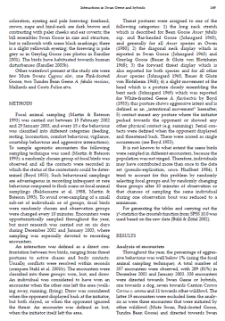
Object
Title: Distribution, Breeding Density and Nest Sites of Hawfinches Coccothraustes coccothraustes in the Primeval Forest of Białowieża National Park
Subtitle:
Rozmieszczenie, gęstość populacji i miejsca lęgowe grubodziobów w pierwotnym lesie Białowieskiego Parku Narodowego ; Hawfinch in primeval forest
Contributor:
Museum and Institute of Zoology, Polish Academy of Sciences
Publisher:
Museum and Institute of Zoology, Polish Academy of Sciences
Place of publishing:
Description:
Type of object:
Abstract:
Long-term observations (1991–2002) have shown that Hawfinches breed throughout the extensive Białowieża Forest; they are only slightly less numerous in the forest interior than at its edge. Population size, habitat and nest sites were studied in two plots in the species-optimal habitat (continuous oak-lime-hornbeam old-growth). The true breeding density there was 4.0–8.4, reaching as much as 15.2 p/10 ha in some years, while, according to the combined territory-mapping method for the same period, it was, on average, 5.8 pairs/10 ha in oak-lime-hornbeam, 3.3 pairs/10 ha in riparian ash-alder, but less than 0.5 pairs/10 ha in mixed coniferous-deciduous or young deciduous stands (marginal habitats for this species). Being among the most numerous species in the Białowieża Forest bird community, Hawfinches hold small nesting territories that are sometimes loosely grouped. Nests are built at an average height of 18.1 (7–34) m in the tree canopy. Hornbeams are the preferred tree species for nesting in the oak-lime-hornbeam stands (also clumps of mistletoe in the continental maple), while black alders in the riparian woodland. Originally, the Hawfinch must have been a species of old, high forests. Its recent nesting elsewhere — low in bushes or, preferably, along woodland edges — is likely to be a secondarily acquired trait; it could also be due to a bias — Hawfinch nests are more easily discovered in such localities.
Relation:
Volume:
Issue:
Start page:
End page:
Detailed Resource Type:
Format:
Resource Identifier:
oai:rcin.org.pl:55542 ; 10.3161/068.040.0208
Source:
MiIZ PAN, call no. P.257 ; MiIZ PAN, call no. P.4568 ; click here to follow the link
Language:
Language of abstract:
Rights:
Terms of use:
Copyright-protected material. May be used within the limits of statutory user freedoms
Digitizing institution:
Museum and Institute of Zoology of the Polish Academy of Sciences
Original in:
Library of the Museum and Institute of Zoology of the Polish Academy of Sciences
Access:
Object collections:
- Digital Repository of Scientific Institutes > Partners' collections > Museum and Institute of Zoology PAS > Scientific Journals
- Digital Repository of Scientific Institutes > Partners' collections > Museum and Institute of Zoology PAS > MIZ PAN Publications > Acta Ornithologica
- Digital Repository of Scientific Institutes > Literature > Journals/Articles
Last modified:
Oct 2, 2020
In our library since:
Jul 28, 2015
Number of object content downloads / hits:
8
All available object's versions:
https://rcin.org.pl/publication/75773
Show description in RDF format:
Show description in RDFa format:
Show description in OAI-PMH format:
Objects Similar
Tomiałojć, Ludwik (1939– )
Tomiałojć, Ludwik (1939– )
Tomiałojć, Ludwik (1939– )
Wesołowski, Tomasz (1950– ) Tomiałojć, Ludwik (1939– )
Tomiałojć, Ludwik (1939– ) Wesołowski, Tomasz (1950– )
Tomiałojć, Ludwik (1939– ) Wesołowski, Tomasz (1950– ) Walankiewicz, Wiesław
Tomiałojć, Ludwik (1939– )
Wesołowski, Tomasz (1950– ) Tomiałojć, Ludwik (1939– ) Mitrus, Cezary Rowiński, Patryk Czeszczewik, Dorota

 INSTYTUT ARCHEOLOGII I ETNOLOGII POLSKIEJ AKADEMII NAUK
INSTYTUT ARCHEOLOGII I ETNOLOGII POLSKIEJ AKADEMII NAUK
 INSTYTUT BADAŃ LITERACKICH POLSKIEJ AKADEMII NAUK
INSTYTUT BADAŃ LITERACKICH POLSKIEJ AKADEMII NAUK
 INSTYTUT BADAWCZY LEŚNICTWA
INSTYTUT BADAWCZY LEŚNICTWA
 INSTYTUT BIOLOGII DOŚWIADCZALNEJ IM. MARCELEGO NENCKIEGO POLSKIEJ AKADEMII NAUK
INSTYTUT BIOLOGII DOŚWIADCZALNEJ IM. MARCELEGO NENCKIEGO POLSKIEJ AKADEMII NAUK
 INSTYTUT BIOLOGII SSAKÓW POLSKIEJ AKADEMII NAUK
INSTYTUT BIOLOGII SSAKÓW POLSKIEJ AKADEMII NAUK
 INSTYTUT CHEMII FIZYCZNEJ PAN
INSTYTUT CHEMII FIZYCZNEJ PAN
 INSTYTUT CHEMII ORGANICZNEJ PAN
INSTYTUT CHEMII ORGANICZNEJ PAN
 INSTYTUT FILOZOFII I SOCJOLOGII PAN
INSTYTUT FILOZOFII I SOCJOLOGII PAN
 INSTYTUT GEOGRAFII I PRZESTRZENNEGO ZAGOSPODAROWANIA PAN
INSTYTUT GEOGRAFII I PRZESTRZENNEGO ZAGOSPODAROWANIA PAN
 INSTYTUT HISTORII im. TADEUSZA MANTEUFFLA POLSKIEJ AKADEMII NAUK
INSTYTUT HISTORII im. TADEUSZA MANTEUFFLA POLSKIEJ AKADEMII NAUK
 INSTYTUT JĘZYKA POLSKIEGO POLSKIEJ AKADEMII NAUK
INSTYTUT JĘZYKA POLSKIEGO POLSKIEJ AKADEMII NAUK
 INSTYTUT MATEMATYCZNY PAN
INSTYTUT MATEMATYCZNY PAN
 INSTYTUT MEDYCYNY DOŚWIADCZALNEJ I KLINICZNEJ IM.MIROSŁAWA MOSSAKOWSKIEGO POLSKIEJ AKADEMII NAUK
INSTYTUT MEDYCYNY DOŚWIADCZALNEJ I KLINICZNEJ IM.MIROSŁAWA MOSSAKOWSKIEGO POLSKIEJ AKADEMII NAUK
 INSTYTUT PODSTAWOWYCH PROBLEMÓW TECHNIKI PAN
INSTYTUT PODSTAWOWYCH PROBLEMÓW TECHNIKI PAN
 INSTYTUT SLAWISTYKI PAN
INSTYTUT SLAWISTYKI PAN
 SIEĆ BADAWCZA ŁUKASIEWICZ - INSTYTUT TECHNOLOGII MATERIAŁÓW ELEKTRONICZNYCH
SIEĆ BADAWCZA ŁUKASIEWICZ - INSTYTUT TECHNOLOGII MATERIAŁÓW ELEKTRONICZNYCH
 MUZEUM I INSTYTUT ZOOLOGII POLSKIEJ AKADEMII NAUK
MUZEUM I INSTYTUT ZOOLOGII POLSKIEJ AKADEMII NAUK
 INSTYTUT BADAŃ SYSTEMOWYCH PAN
INSTYTUT BADAŃ SYSTEMOWYCH PAN
 INSTYTUT BOTANIKI IM. WŁADYSŁAWA SZAFERA POLSKIEJ AKADEMII NAUK
INSTYTUT BOTANIKI IM. WŁADYSŁAWA SZAFERA POLSKIEJ AKADEMII NAUK


































